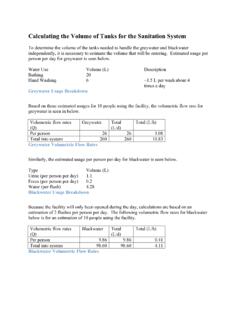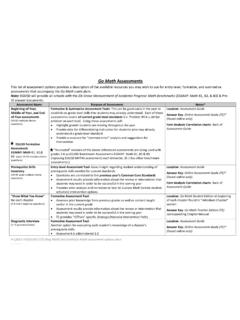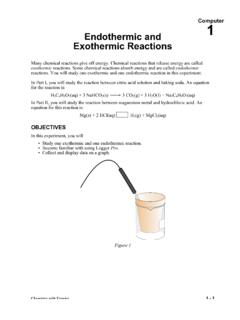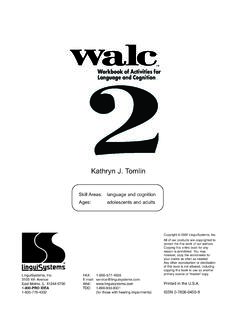Transcription of Critical Thinking & Classic Tales FABLES
1 A TEACHING RESOURCE Copyright by Remedia Publications, Rights Reserved. Printed in the purchase of this book entitles the individual teacher to reproducecopies for classroom use. The reproduction of any part for anentire school or school system is strictly find Remedia products in a store near you, visit: PUBLICATIONS, N. 76TH STREET SUITE 120 SCOTTSDALE, AZ 85260 REM 452A 2003 FABLESAUTHORSM arion HindesSally SwitzerILLUSTRATORJohn LakeyCritical Thinking & Classic TalesA fable is a special kind of folktale. Folktales are storieshanded down by word of mouth. Many are eventually writtendown. Like folktales, FABLES are found in cultures all over theworld, from India to Africa to Eurasia. Aeosop s FABLES , credited toa Greek slave, are some of the earliest and most fable has a number of interesting characteristics.
2 Italways teaches a lesson, or moral. Usually the characters are animalsthat are given human traits, which is an example of fable is fiction. It is also fantasy always in the realm of theimpossible or improbable. Finally, a fable is a form of allegory afictional story whose symbolic meaning is more important than itsliteral twelve FABLES in this book are each followed by acrossword puzzle that tests literal comprehension, as well as a setof comprehension questions based on the six levels of Bloom sTaxonomy: knowledge, comprehension, application, analysis,synthesis, and evaluation. Since the exercises range from simpleto complex, they are ideal for the differentiated following is a more detailed explanation of the types ofthinking skills involved at each level of Bloom s Taxonomy.
3 It willhelp you understand why the comprehension and Critical thinkingquestions are labeled and worded as they are. Keep in mind thatthese categories will overlap and intertwine. You will also findthat many skills apply to more than one level of Bloom s Taxonomy. Knowledge: reading for details, finding facts, recallinginformation Comprehension: identifying the main idea, summarizing,determining sequence. Higher level comprehension skillsinclude classifying, identifying cause and effect, makinginferences, drawing conclusions, and predictingconsequences of behavior. Application: applying story content to real life or topersonal experience, converting abstract content toconcrete situations, making use of knowledge learned Analysis: completing analogies, using logic, identifyingthe unstated moral of a story, recognizing patterns ofbehavior, breaking a whole into its component parts, seeinghow parts relate to the whole, classifying Synthesis: predicting outcomes, drawing conclusions,comparing/contrasting, relating knowledge from severaldifferent areas, generalizing from given facts, combiningparts of a whole in a new and different way Evaluation.
4 Making judgments, forming/expressingpersonal values, expressing/justifying an opinion,discerning fact from opinion, evaluating facts for accuracyABOUT THIS BOOK Remedia Publications45 Critical Thinking & Classic Tales : FablesIn addition to FABLES , crossword puzzles , and questions basedon Bloom s Taxonomy, this book features several literatureresponse activities: The Venn Diagram Compare/Contrast Chart,the Story Map, Story Sequence, and a challenge activity calledAbout This Story. Venn Diagram Compare/Contrast Chart: to helpstudents increase their comprehension of a story byshowing similarities and differences between characters(either in the same story or in two different stories) orbetween stories (for example, comparing or contrastingstory plots, morals, or recurring themes) Story Map: to help the teacher assess the student s abilityto recall the main events in the plot that move the storytoward its resolution Story Sequence: to help students understand the mostimportant events in a story and that those events happenin a certain sequence.
5 The time-order words will helpstudents organize their thoughts. About This Story: to help those students who are capableof exploring the elements of a story, such as, characters,plot, setting, theme, recurring themes, personification,author s purpose, high-quality audio CD, which may be found inside theback cover of this book, follows each story word for will find the Chart of Skills (inside the front cover) to bea valuable teaching tool. It shows precisely which skills aretargeted in every story. The chart will enable you to choose aselection according to the skills it covers, or to simply be informedabout the skills you will be teaching with each For Using This Book: Use the stories and follow-up activities with individualstudents or with small groups of students who are readingat the same level.
6 They make an excellent at-home practiceor partner reading activity. Oral discussion of work as it iscompleted will increase the level of student understanding. The audio CD is ideal for use with students who areexperiencing reading difficulties. By listening to the storyor following along as it is being read, those students willhave a greater chance at comprehension Thinking & Classic Tales : Fables46 Remedia PublicationsTHE MAN, THE BOY, AND THE DONKEY .. 2 crossword 3 THE CROW AND THE PITCHER .. 5 crossword 6 THE FOX WITH NO TAIL .. 8 crossword 9 THE CITY MOUSE AND THE COUNTRY MOUSE .. 11 crossword 12 THE ANT AND THE GRASSHOPPER .. 14 crossword 15 BELLING THE CAT .. 17 crossword 18 THE LION AND THE MOUSE .. 20 crossword 21 ANDROCLES AND THE LION .. 23 crossword 24 THE FOX AND THE CAT.
7 26 crossword 27 THE BAT, THE BIRDS, AND THE BEASTS .. 29 crossword 30 THE FOX AND THE GRAPES .. 32 crossword 33 THE BOY WHO CRIED WOLF! .. 35 crossword 36 VENN DIAGRAM COMPARE/CONTRAST CHART .. 38 STORY MAP .. 40 STORY SEQUENCE .. 41 ABOUT THIS STORY .. 42 ANSWER KEY ..43-44 CONTENTS Remedia Publications1 Critical Thinking & Classic Tales : FablesName _____THE MAN, THE BOY, AND THE DONKEYSEQUENCE these events in the order they happened:_____ They passed some women in a Young girls laughed at They tried to carry the Old men talked badly about to do then. Finally, he decided thatthey would carry the donkey. They tiedthe donkey's feet to a long pole. Byputting the pole on their shoulders theycould carry the donkey upside downbetween donkey did not like to ride thisway and began to kick his feet.
8 The boydropped his end of the pole. The donkeyfell into the river and farmer and his son learned thelesson that if you try to please everybody,no one will be farmer and his son were going intotown with their donkey. As the threewalked along, some young girls pointed atthem and began to laugh. The girls thoughtthat it was strange that they didn't ride thedonkey. The farmer told his son to get onthe donkey and ride. He did not wantthem to look little farther down the road, theypassed some old men who began to talkabout them. The old men said that it waswrong for the son to ride and the father towalk. The farmer had his son get off thedonkey so that he could ride it himself. Hedid not want the old men to think the boywas they passed some women in thefields. The women were shocked that thefather would ride and make the little boywalk.
9 The father decided to bring the boyup on the donkey with the town, some people thoughtthat the farmer and his son were beingmean to the donkey. They said the loadwas too heavy. The father did not know452A CT& , 10:38 AM1 Critical Thinking & Classic Tales : Fables2 Remedia PublicationsName _____READING FOR DETAILS KNOWLEDGE & were girls laughing at the farmer and his son? did the old men think it was wrong for the boy to ride alone? were the women in the fields shocked about? did the townspeople think the father and his son were mean to the donkey? is the moral of this story? _____CAUSE AND EFFECT caused the donkey to drown? was the pattern of behavior of the father and son (what did they do over andover)? did the people they met do over and over? a time when you or someone you know got into trouble trying to pleasetoo many people.
10 (You may use another sheet of paper.)THE MAN, THE BOY,AND THE DONKEY452A CT& , 10:38 AM2 Remedia Publications3 Critical Thinking & Classic Tales : FablesName _____ACROSS1. The boy ___ his end of the The girls thought it was ___ that theydidn t ride the The girls began to ___ at the three The farmer and his son carried thedonkey ___ down on a The man was a The farmer did not want the old men tothink his son was The farmer, his son, and the ___ weregoing into They were going ___ The donkey ___ in the MAN, THE BOY,AND THE DONKEYDOWN2. The donkey fell into the They tied the donkey to a long They carried the pole on their The farmer did not want to look ___ tothe Some ___ thought that the farmer andhis son were being mean to the If you try to please everybody, no onewill be The farmer and his son tried to ___ thedonkey on a The women were in the They were going into The farmer told his son to ___ CT& , 10:38 AM3 Critical Thinking & Classic Tales : Fables4 Remedia PublicationsName _____THE CROW AND THE PITCHERA crow had been flying for a long timeand was very thirsty.














